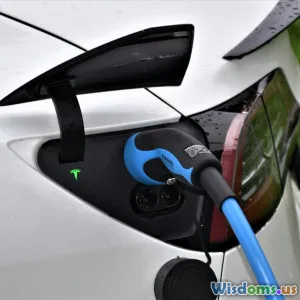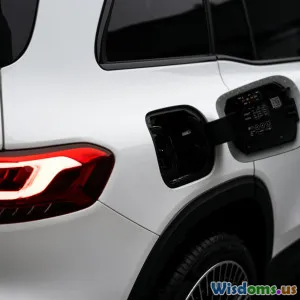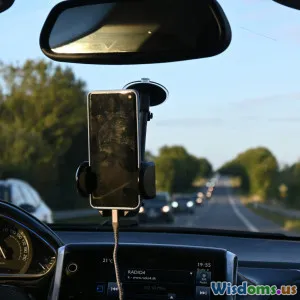
Five Hidden Downsides of Wireless Vehicle Charging Explained
10 min read Explore the lesser-known challenges of wireless vehicle charging beyond the tech hype. (0 Reviews)
Five Hidden Downsides of Wireless Vehicle Charging Explained
In a world that's rapidly embracing electric vehicles (EVs), the convenience of wireless vehicle charging (WVC) promises to revolutionize how we power our rides. Imagine driving into your garage and having your car automatically recharge without a single physical cable. Sounds like the future, doesn't it? But as alluring as the idea is, there's more lurking beneath this technological marvel. From increased energy loss to health concerns, wireless charging carries hidden pitfalls that are crucial for consumers, manufacturers, and policymakers alike.
In this article, we'll delve into five lesser-known downsides of wireless vehicle charging, shedding light on the complexities behind a seemingly seamless technology.
1. Efficiency Losses Resulting in Higher Energy Consumption
Wireless charging systems typically employ electromagnetic induction to transfer energy from a charging pad to the vehicle’s receiving coil. However, this method inherently suffers from energy loss due to factors such as coil misalignment, air gap distance, and electromagnetic interference.
Real-World Efficiency Metrics
Studies like those from the U.S. Department of Energy's Argonne National Laboratory have indicated that wireless EV charging systems often achieve efficiency rates between 80% to 90%, whereas wired chargers frequently reach 95% or higher.
To put that into perspective, if a vehicle requires 30 kWh of energy, a wired charger would consume approximately 31.6 kWh from the grid considering losses, while a wireless system, at 85% efficiency, could draw closer to 35.3 kWh. This difference translates to additional energy costs over time and potentially more emissions if the electricity source isn't fully renewable.
Impact on Charging Speed
Lower efficiency can also mean longer charging times or larger energy bills, undermining some of the convenience that wireless charging promises. Drivers might find themselves needing to top-up more frequently or waiting longer for full charges.
2. High Initial Installation and Infrastructure Costs
While wireless charging eliminates the inconvenience of plugging in cables, setting up these systems is no trivial task. The hardware and infrastructure needed for wireless charging stations tend to be significantly more expensive than conventional wired charging setups.
Cost Analysis
Freely accessible research by Navigant Research points to installed wireless charging station costs exceeding wired options by as much as 30% to 50%. This includes:
- Complex charging pads: Designed to handle precise electromagnetic field emissions
- Control and communication modules: To ensure safe and efficient energy transfer
- Infrastructure modifications: Particularly in public or heavily trafficked areas to embed charging pads flush with the driving surface
Commercial Deployment Challenges
Companies like Qualcomm and WiTricity, pioneers in wireless EV charging, have cited high costs and regulatory hurdles as significant barriers to widespread adoption. Some pilot projects have been scaled down or delayed because initial costs do not justify immediate returns.
This cost premium will likely be passed on to consumers, though time and technological advances may help lower expenses in the future.
3. Compatibility and Standardization Issues Impede Broad Adoption
Wireless charging for EVs is not yet standardized across all manufacturers or models. This diversity brings about compatibility frustrations for consumers and complexities for charging network operators.
Fragmented Industry Landscape
Different wireless charging systems operate at varying power levels (from 3.3 kW to over 22 kW) and use diverse communication protocols. For example, the SAE J2954 wireless charging standard is currently being adopted in the U.S., but not all manufacturers embrace it unequivocally.
User Experience Consequences
A Tesla owner might find that their wireless charging pad isn’t compatible with their vehicle model or that it charges at a lower speed due to mismatched systems. Likewise, public charging stations must juggle multiple standards or face reduced usability.
Industry Perspectives
Industry experts, such as those quoted by Electrek and InsideEVs, warn that until global standards are harmonized, wireless charging may remain a niche convenience rather than a universal solution.
4. Health and Safety Concerns Related to Electromagnetic Fields
The wireless charging process relies on creating strong electromagnetic fields (EMFs) between the charger and the vehicle receiver. This raises questions about potential health impacts for humans and interference with electronic devices.
Scientific Findings and Regulatory Guidelines
Many health organizations, including the World Health Organization, have evaluated the risks of non-ionizing EMFs. While low-level, short-term exposures typical around consumer electronics aren't generally harmful, continuous exposure near high-power wireless chargers specifically designed for vehicles is less studied.
Potential Risks
Critics argue that prolonged exposure to elevated EMFs could affect sensitive populations or disrupt medical implants such as pacemakers. Additionally, wireless charging pads installed in public spaces could pose unknown cumulative risks to bystanders over the years.
Mitigation Measures
To address concerns, industry players include shields to limit stray emissions, safety sensors to shut down charging if foreign objects are detected, and adhere to EMF exposure limits set by agencies such as the International Commission on Non-Ionizing Radiation Protection (ICNIRP). Nonetheless, naysayers urge ongoing research and cautious implementation.
5. Environmental and Durability Challenges Over Time
Despite often being marketed as eco-friendly, wireless charging systems come with unique environmental considerations related to their durability, maintenance, and lifecycle.
Increased Wear and Tear
Charging pads embedded in parking lots or garage floors face harsh environmental factors, including weather exposure, debris accumulation, and physical impacts. These vulnerabilities increase the frequency of maintenance or replacements.
For example, a pilot project by the Australian government's Electric Vehicle Council observed common pad degradation after extended use, resulting in significant maintenance costs.
Environmental Footprint of Production
Manufacturing wireless charging components involves rare earth magnets, copper wiring, and specialized electronics—materials with notable environmental extraction footprints.
Disposal and Recycling Issues
Currently, there is limited infrastructure for recycling the complex electronics and magnetic elements used in wireless chargers, potentially leading to e-waste challenges as adoption scales.
Balancing the desire for seamless charging against these ecological impacts is essential for sustainable technology deployment.
Conclusion: The Hidden Complexities Behind Wireless Charging Tech
Wireless vehicle charging undoubtedly represents a step toward futuristic convenience and could simplify the EV experience significantly. However, the five hidden downsides—efficiency losses leading to higher energy consumption, increased costs, compatibility hurdles, health and safety debates, and environmental durability issues—highlight that adoption is not without complications.
As consumers, understanding these challenges enables more informed decisions about investing in wireless charging solutions. Meanwhile, manufacturers and policymakers must tackle these issues through technological innovation, rigorous safety standards, and establishing global standards for compatibility.
In essence, wireless vehicle charging is a promising technology still in its adolescence. Recognizing its pitfalls alongside its perks will help the automotive industry steer toward a smarter, safer, and more sustainable electric mobility future.
References:
- U.S. Department of Energy, Argonne National Laboratory’s Wireless Charging Study
- Navigant Research, Wireless EV Charging Market Reports
- World Health Organization, EMF and Public Health
- Electric Vehicle Council, Australia—Pilot Wireless Charging Program
- SAE International, J2954 Wireless Charging Standard Documentation
- Electrek, InsideEVs Industry Articles and Expert Interviews
Rate the Post
User Reviews
Other posts in Sustainable Transportation
Popular Posts
















